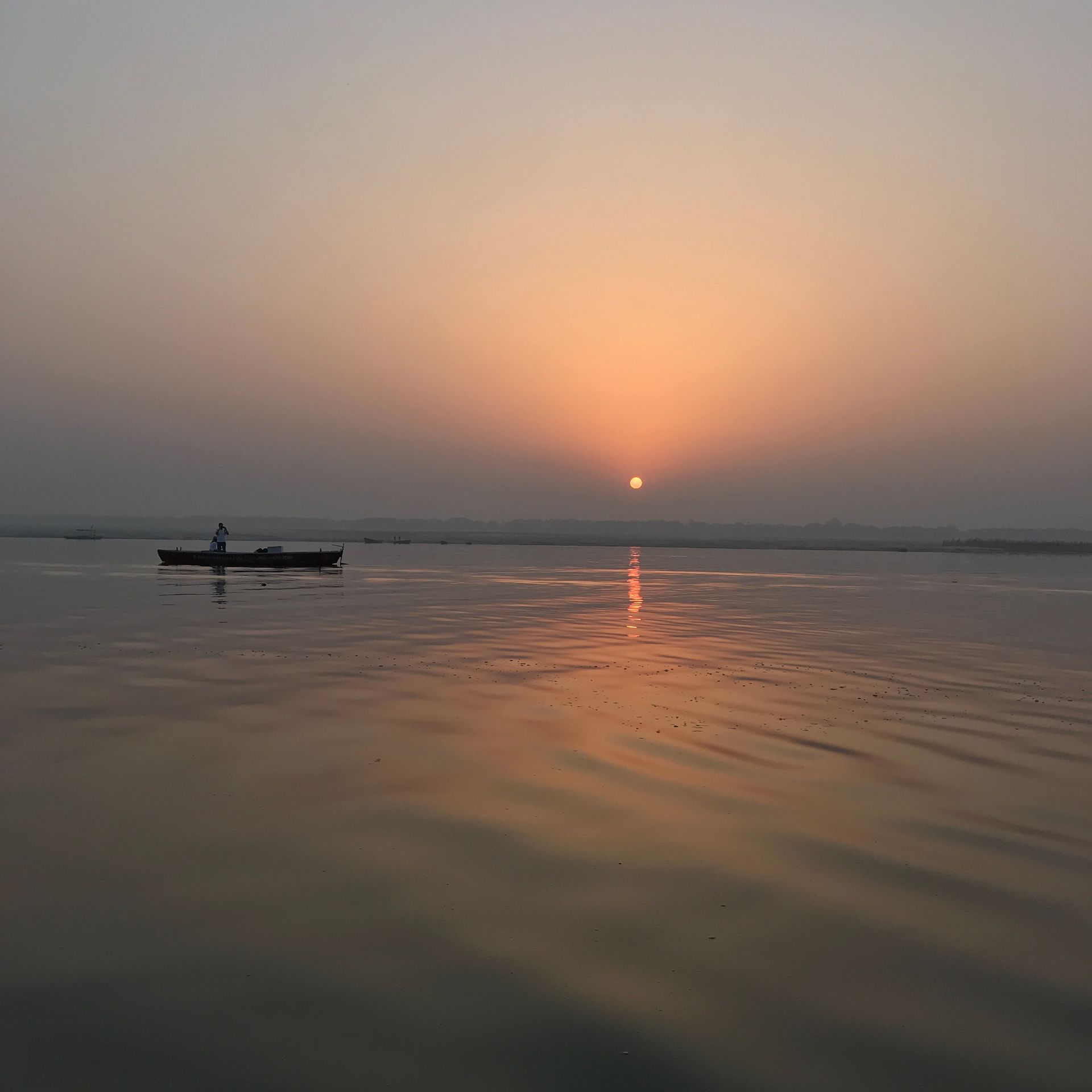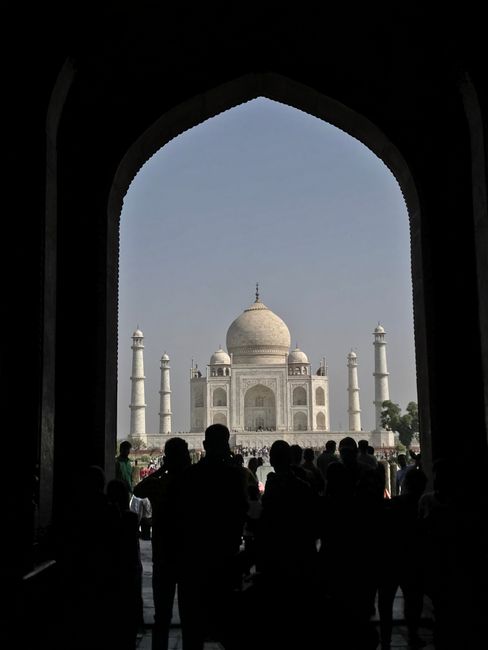Welcome to Jaipur
Veröffentlicht: 09.05.2019
Newsletter abonnieren
Last Stop: Jaipur.
Arriving in Jaipur in the dark, I was definitely able to say that it was the most civilised looking city from all the cities I’ve seen in India. Another thing was, that also here the amount of flies wouldn’t become less. It literally seems like the majority of the fly population in the world have settled in India.
The next morning we woke up at 5 am to go for a walking tour by a local who would show us hidden spots and local favourites. We walked through small alleys and got to experience how the city wakes up; morning routines, prayers and markets.
It was a very impressive tour and I learned quite a lot about the city itself.
Jaipur is the first planned city of India and was built by Maharaja Jai Singh in 1727. The need to shifting his capital city arose due to the increase in population and growing water problem, that he faced in the former capital Amber. Amber was built in between mountains, so as the population started to increase there was no space to expand and hence as the former ruler Maharaja Jai Singh had great influence over the empire, he decided to move the city slightly outwards, which is now Jaipur.
Jaipur was built in 7 sections. Two off which were administrative sections and the outer five residential and commercial sections. Hence most people lived on the first or second floor, as the ground floors were occupied commercially.
When I mentioned that Jaipur seemed the most civilised city, I meant that it was way more organised than the other cities. The city was built on an efficient grid system with perfect intersections, where every small street leads to a large street.
Jaipur has an outer wall and an inner wall, where the inner wall was meant to protect the centre of the city where the more important people used to live. The walls are extremely strong and its said that there has never been an army that was able to break through. In total there are 7 gates along the walls, where the design of the arches are off Turkish/ Persian architectural influence. The gates were used as check points for import and export of Goods, and during that time there was a lot of money generated at these sections.
The city has a total off 4000 temples. Some off which are big ones and some off which are called “drive threw” temples. These were built for the busy and hard working people that wouldn’t have the time to visit the proper temples, and hence needed a quick alternative. The major difference between a Krishna and Shiva temple (two of the gods), is that at a Krishna temple the people stand outside offering prayers and are chanting to the altar and at the Shiva temple you can go all the way in and place your offerings right at the altar, hence its said to be much more informal. The Shiva temples are also marked with a trident on the roof. 🔱
The big Krishna temple was the first thing built in Jaipur, then the empire was built around it and lastly the rest of the city around the empire. Hence the temple marks the centre of the city.
The royal family still lives in parts of the palace. Even though there is no official king anymore, the people call one fo the only left royal family members, the 22 year old ‘handsome’ young man, who is pursuing a degree in NY, their king.
Jay sing built the city flawlessly. The way he populated the city, was off great advantage. He brought skilled people from all over into the city, that were the best in their degree; carving stone, metal works, jewellery and fabric! He effectively created a supermarket, by aufteilen those people into different parts of the city.
That’s why still today when you are looking for something, there are bazaars simply serving one purpose (i.e: jewelry, fabric etc.). The name ‘Pink City’, what a lot of people refer Jaipur too, comes from the color of the buildings. The color is a symbol of hospitality in India and they were painted this way to welcome the Prince of Whales when he came to visit Jaipur. The wife of Jaipur’s King at that time, fell in love with the color and insisted that it would stay like that. So in 1877 it was decided by law that everyone had to keep the color as it was. The guide told us that the color is actually not pink, but that due to an article that was published in Britain calling Jaipur the ‘pink city’, this is how everyone calls it now.
One of the morning routines we experienced was how the MILCH VERKAUF people bought their milk for cooking. The farmers travel 40-60 km every day to arrive in Jaipur around 7am for the VERKAUF. Which means they get up extremely early in order to milk the cows and make their way into the city.
The way the milk gets sold, was very interesting. The price is determined by the fat content of the milk; the thicker, the more expensive. And in order to check the fat content, the people dip their whole hands into the pots of milk and according to the way the milk drops of their fingers, is how they decide. Kind of disgusting… and definitely not hygienic!!
But the guide told us that when the milk is brought home, the people cook it multiple times before drinking it, in order to kill the bacteria. He said that approximately one litre of milk costs around 40-60 Rupees, which is around 60 cents. The majority of the milk is cow milk, but they also sell buffalo or goats milk (the least popular).
When I asked our guide about what the people earn approximately, he said that the income for an unskilled job is around 500 Rupees for an 8 hour day, which is about 8 Euros. Its crazy thinking about it… as this is our MINDEST STUNDENSATZ.
After the walking tour we had a quick breakfast and as time was limited, we went straight to our next sightseeing tour. A must see, is the Amber Fort. That was the fort in the former capital city. It was built during the Hindu Dynasty and when the government took over the royal family was asked to move out and are now residenting in the old town of Jaipur (inside the inner wall).
The wall surrounding the fort is referred to as the “Mini Wall of China” and is approximately 11km long. It used to mark the outside of the former capital, amber.
The walls and carpets that decorated the fort, were painted with vedvegetable colours, what Jaipur is known for. Green comes from Spinach, Yellow from turmeric and Red from sugar cane or beetroot and so on.
One of the most impressive things I saw that day, was the Observatory. Its one of the Worlds Heritage Sites, due to the presence of the largest sun dial in the world, where you are able to see the time accurate by two seconds. We calculated the time and I couldn’t believe that it told me the exact time. Its incredible what people back then were able to invent, that still functions hundreds of years later.
Next to the sun dial, there were other measuring devices that would calculate your fortune according to your horoscope sign. The guide explained that in the Indian culture the horoscope has very high meaning. When a child is born, the first thing the family does is a horoscope chart, to see how the future of the child looks like. These charts tell them about the wealth and health situation of their child and in case something negative shows up, they have specific “doctors” (astrologers) who’s job it is to treat the child by telling the families what to do or change in order to alter the future determined by the horoscope. Also when people want to get married in India, they first have to check if their horoscopes match/ work together. Otherwise they can’t get married haha
Imagine you are crazy in love with someone and just because you are told that your horoscopes don’t match, you can’t stay together…
Well… That was our day in Jaipur. I am extremely glad that I had the time to see this city before heading home. There is soooo much more to see in India and I can’t wait until I’m back to explore the rest!!
Newsletter abonnieren
Antworten

